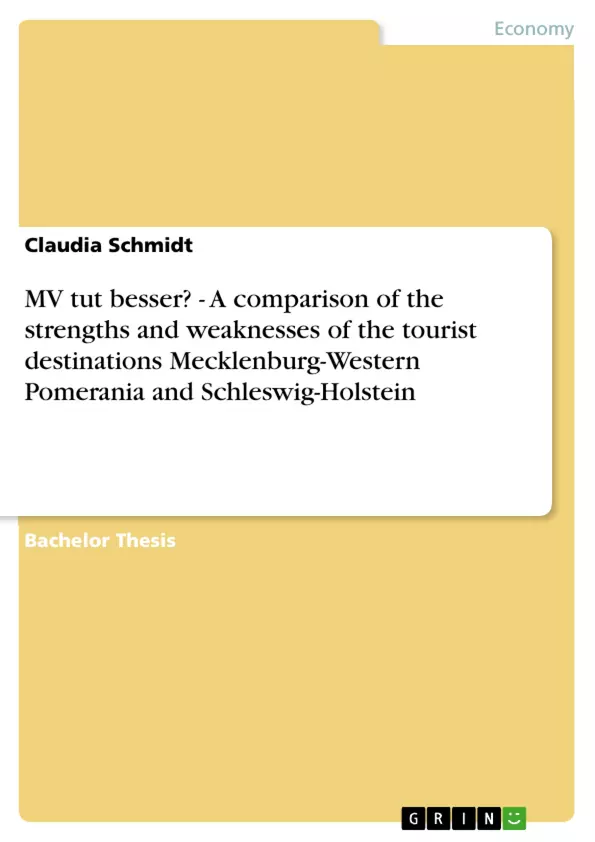This thesis analyzes which one of the two Federal States mentioned has better tourist resources and which one fails in bailing the whole tourist potential. First of all some general facts about the German tourism will be presented to frame the overall picture. The theoretical part gives a definition of the expression “destination” and explains the tasks of a destination management which will then give the basis to achieve better understanding of the concrete discussion later on. At this point Steinecke’s remarks to this topic will be put a special attention to. Going on with a description of the natural location conditions of the two mentioned tourist destinations will make the incentives obvious to come to visit the Northern part of Germany.
In detail the location and the population will be described and similarly the local importance of tourism will be made clear by presenting the numbers of visitors. Furthermore the fundamental knowledge will be applied to discuss the current operational state. Therefore the infrastructure, arranged events, the special offers for a family, an active or a wellness vacation will be presented and compared. In addition to that the important tourist websites will be shed light on to eventually result in an overall argumentation presented in a SWOT-analysis. Afterwards it will be made clear that on a certain level a competition is realistic and good and that the two destinations have understood that there are levels where they should rather act like partners instead of offenders. Finally this assignment will give suggestions to improve the current operational state and then be concluded.
Inhaltsverzeichnis (Table of Contents)
- Introduction
- Subject and Objectives
- Approach
- Fundamentals
- The German Tourism
- General facts
- What is a "destination"? Definitions and Explanations
- Destination management - Definitions and Explanations
- Dr. Albrecht Steinecke's bricks for a successful destination management
- Applying Steinecke's explanation of destination management to MV and SH
- The destination Mecklenburg-Western Pomerania
- Location
- Landscape
- Population
- The destination Schleswig-Holstein
- Location
- Landscape
- Population
- The comparison
- The number of visitors
- The number of visitors of MV
- The number of visitors of SH
- The number of visitors - A comparison
- The Infrastructure
- The infrastructure of Mecklenburg-Western Pomerania
- Infrastructure of Schleswig-Holstein
- Infrastructure - A comparison
- An update through events
- What is an “event”? – Definition and explanation
- Events in Mecklenburg-Western Pomerania
- Events in Schleswig-Holstein
- Events - A comparison
- Experience orientation by animation
- Examples for Mecklenburg-Western Pomerania
- Examples for Schleswig-Holstein
- Family vacation
- Family vacation in MV
- Family vacation in SH
- Family vacation - A comparison
- Active vacation
- Active vacation in MV
- Active vacation in SH
- Active vacation - A comparison
- The focus on "Wellness"
- Wellness in Mecklenburg-Western Pomerania
- MV promoting wellness on the internet
- Wellness in Schleswig-Holstein
- SH promoting wellness on the internet
- Wellness - A comparison
- The internet as the new media – structure and evaluation of the important tourist websites
- General facts
- The analysis
- The tourist websites of MV
- The tourist websites of SH
- The tourist websites - A comparison
- The SWOT-analysis
- What is a "SWOT-analysis"? A definition
- The SWOT-analysis of the destination MV
- Strengths
- Weaknesses
- Opportunities
- Threats
- The SWOT-analysis of the destination SH
- Strengths
- Weaknesses
- Opportunities
- Threats
- The latest cooperation in the tourism sector
- Suggestions for improvement
- The importance of competition in the tourism industry
- Analyzing the strengths and weaknesses of tourist destinations
- Evaluating the infrastructure and services offered by both Mecklenburg-Western Pomerania and Schleswig-Holstein
- Comparing the effectiveness of various marketing strategies
- Exploring the impact of events and experience orientation on tourism development
Zielsetzung und Themenschwerpunkte (Objectives and Key Themes)
This bachelor thesis aims to compare the strengths and weaknesses of Mecklenburg-Western Pomerania and Schleswig-Holstein as tourist destinations, ultimately determining which has a better competitive advantage. By applying fundamental tourism knowledge, the thesis analyzes the factors contributing to success or failure in the tourism industry.
Zusammenfassung der Kapitel (Chapter Summaries)
The introductory chapter establishes the context for the thesis, highlighting the role of competition in the tourism industry. It introduces the two destinations under study, Mecklenburg-Western Pomerania and Schleswig-Holstein, and outlines the objective of comparing their strengths and weaknesses.
Chapter 2 provides essential theoretical foundations. It delves into the nature of tourism, defining "destination" and explaining the concepts of destination management. This chapter further explores the framework of Dr. Albrecht Steinecke, presenting his principles for successful destination management and applying them to the context of the two regions.
Chapters 3 and 4 present comprehensive descriptions of the individual destinations, focusing on their geographical location, landscape features, and population characteristics. These chapters provide a foundational understanding of the unique qualities of each region.
Chapter 5 delves into the core comparative analysis. It compares the two destinations in various aspects, including visitor numbers, infrastructure, event offerings, experience orientation, family vacation appeal, active vacation opportunities, and wellness services. The chapter examines the strengths and weaknesses of each destination based on these elements.
Chapter 6 introduces the SWOT analysis, a strategic tool for evaluating internal strengths and weaknesses, as well as external opportunities and threats. It applies the SWOT analysis to both Mecklenburg-Western Pomerania and Schleswig-Holstein, providing a comprehensive assessment of their competitive positions.
Schlüsselwörter (Keywords)
This bachelor thesis focuses on the keywords of tourism, destination management, strengths and weaknesses, competitive advantage, Mecklenburg-Western Pomerania, Schleswig-Holstein, SWOT analysis, events, experience orientation, family vacation, active vacation, wellness, and internet marketing.
- Citation du texte
- Claudia Schmidt (Auteur), 2006, MV tut besser? - A comparison of the strengths and weaknesses of the tourist destinations Mecklenburg-Western Pomerania and Schleswig-Holstein, Munich, GRIN Verlag, https://www.grin.com/document/61061



